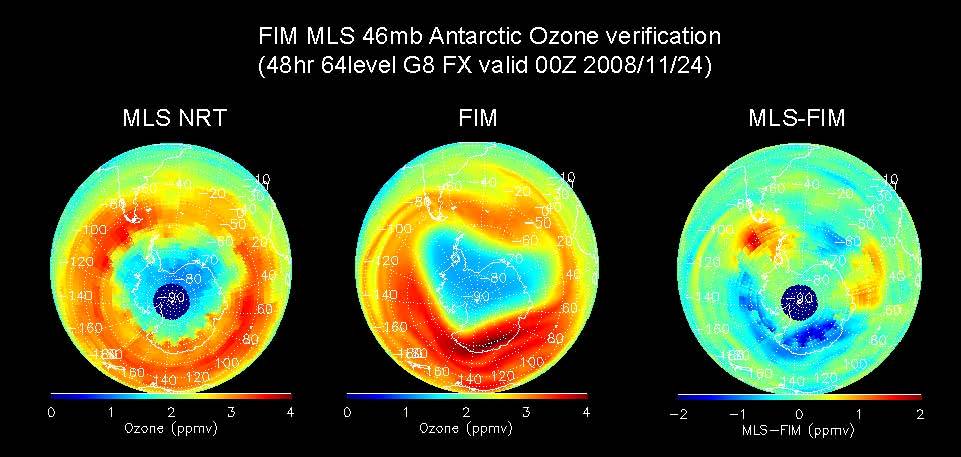 |
ASPB and CIMSS Weekly Report
[ Archive ] |
 |
ASPB AND CIMSS WEEKLY HIGHLIGHTS FOR THE WEEK ENDING NOVEMBER 29, 2008
IN THE PRESS:
ITEMS FOR THE ADMINISTRATOR:
ITEMS FOR THE ASSISTANT ADMINISTRATOR:
ITEMS FOR THE OFFICE DIRECTOR, STAR:
ITEMS FOR THE DIVISION CHIEF, CoRP:
Manuscript on Photolysis Cloud Sensitivites Submitted to JGR: A manuscript entitled "Sensitivity of photolysis frequencies and key tropospheric oxidants in a global model to cloud vertical distributions and optical properties" was submitted to the Journal of Geophysical Research-Atmospheres. The manuscript assesses the radiative effects of clouds on tropospheric chemistry, including an analysis of the sensitivity of such effects to cloud vertical distributions and optical properties in a global 3-D chemical transport model. The results have important implications for model intercomparisons and climate feedback on tropospheric photochemistry. The authors are Hongyu Liu, James H. Crawford, David B. Considine, Steven Platnick, Peter Norris, Bryan N. Duncan, Robert B. Pierce (NESDIS), Gao Chen, and Robert M. Yantosca. (R.B. Pierce, E/RA2, 608-890-1892, brad.pierce@noaa.gov)
GOES-13 Imager 13.3 Micrometer Spectral Response Function Issue: During the Geostationary Operational Environmental Satellite (GOES)-13 post-science test analysis, comparisons with high-spectral resolution Atmospheric InfraRed Sounder (AIRS) data and with broadband High-resolution Infrared Radiation Sounder (HIRS) data on National Oceanic and Atmospheric Administration (NOAA)-15 and NOAA-16 show that there appears to be a cold bias on the order of -2 K in the GOES-13 Imager band 6 (13.3 micrometer). It was determined that this was most likely due to a poorly characterized spectral response function (SRF). This led to the instrument vendor, ITT, releasing a new SRF for this band which effectively shifted the center by -1 wavenumbers and changed the shape. The new SRF was tested on recent GOES-13 data from August through November 2008 and it was confirmed through comparisons to AIRS that it indeed improves the comparisons. The SRF could be shifted more to reduce the bias, and apparent error in the band, and discussions are under way with X. Wu of NOAA. (M. Gunshor, CIMSS, 608-263-1146, T. Schmit, E/RA2, 608-263-0291, tim.j.schmit@noaa.gov)
Real-time Stratospheric Ozone Verification: Cooperative Institute for Meteorological Satellite Studies (CIMSS) and NOAA Earth System Research Laboratory (ESRL) scientists have begun verification of stratospheric ozone forecasts from the Finite-Volume, Flow-Following, Icosahedral Model (FIM) using near real-time ozone retrievals from the Microwave Limb Sounder (MLS) onboard the NASA Aura satellite. FIM is a new global weather prediction model currently under development in the Global Systems Division of NOAA/ESRL and is a candidate component of future NOAA global modeling system (R.B. Pierce, E/RA2, 608-890-1892, brad.pierce@noaa.gov)
 (Click image to enlarge)
(Click image to enlarge)
Figure caption: Antarctic near real-time (NRT) Microwave Limb Sounder (MLS) ozone measurements (left), FIM 48 hr ozone forecast (middle), and differences (right) at 46 mb on November 24, 2008. MLS data between 12Z November 23 and 12Z November 24 were used to construct the observed ozone distribution. 48 hr FIM forecast is valid at 00Z on November 24, 2008.
VISITORS:
NEXT WEEK:
LOOKING AHEAD:




 (Click image to enlarge)
(Click image to enlarge)